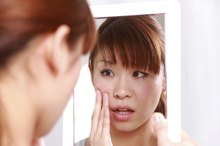Detergent Allergy Symptoms
Allergies to detergents often develop suddenly after a period of intense exposure, such as on the job. However, people can also use a certain product for years without a problem before developing allergy symptoms. Symptoms may arise from direct skin contact with laundry detergents or from the soap residues left on clothing or bedding. Making diagnosis even more difficult, patients can suffer allergic reactions to many ingredients in cleaning products. Adverse symptoms frequently arise from contact with perfumes, abrasives, bleaching compounds and other detergent components.
Itching, Burning or Stinging
Skin that itches in patches, especially where clothing touches it, may be a sign of allergic contact dermatitis from detergents. When the body mistakes an ingredient in laundry detergent for harmful bacteria, it initiates an inflammatory response by sending histamine chemicals into the bloodstream. Local itching results. Ensuring that soap contact, rather than fabric abrasion, caused the itching sensations will lead to a correct diagnosis.
Detergents may contain dozens of ingredients, many of which trigger allergic reactions in some individuals. According to the American Academy of Dermatology, fragrances, dyes and preservatives provoke the majority of reactions 1. Other potentially allergenic ingredients include ammonia, petroleum distillates, polymers and synthetic surfactants. Some patients may experience burning or stinging allergy symptoms as well.
- Skin that itches in patches, especially where clothing touches it, may be a sign of allergic contact dermatitis from detergents.
- Ensuring that soap contact, rather than fabric abrasion, caused the itching sensations will lead to a correct diagnosis.
Inflammatory Symptoms
Face Wash Allergy Symptoms
Learn More
The itchy skin area may next start to swell, developing heat, redness and a raised rash. As inflammation spreads, allergy symptoms may develop in other contact areas. It may be difficult for patients to pinpoint when they were exposed to allergens, since laundry detergent residues can remain in clothing, and clothing can be stored in closets, for long periods of time.
As the University of Maryland Medical Center reports, some ingredients, such as optical brighteners, only cause allergic reactions when they contact the skin that subsequently receives sunlight exposure 2. This may set off more severe rash symptoms, including painful hives or blisters. Fluid-filled blisters eventually drain, sometimes breaking the skin and then crusting over.
- The itchy skin area may next start to swell, developing heat, redness and a raised rash.
- This may set off more severe rash symptoms, including painful hives or blisters.
Allergic Conjunctivitis
Red, itchy, stinging eyes may also affect allergy patients who are sensitized to detergent ingredients. Handling laundry detergents causes skin symptoms on the hands, whereas contact with the eyes creates allergic conjunctivitis, or eye allergy symptoms 3.
Liquid or diluted detergents can splash or migrate from the hands to the eyes. Sensitive patients may experience allergic reactions in the eyes or face from soap residue contact with washcloths or pillowcases. The Cleveland Clinic relates that irritation of the mucous membrane of the eye increases fluid production, resulting in additional conjunctivitis symptoms of overflowing tears 3.
- Red, itchy, stinging eyes may also affect allergy patients who are sensitized to detergent ingredients.
- Sensitive patients may experience allergic reactions in the eyes or face from soap residue contact with washcloths or pillowcases.
Related Articles
References
Writer Bio
Nancy Clarke began writing in 1988 after achieving her Bachelor of Arts in English and has edited books on medicine, diet, senior care and other health topics. Her related affiliations include work for the American Medical Association and Oregon Health Plan.









